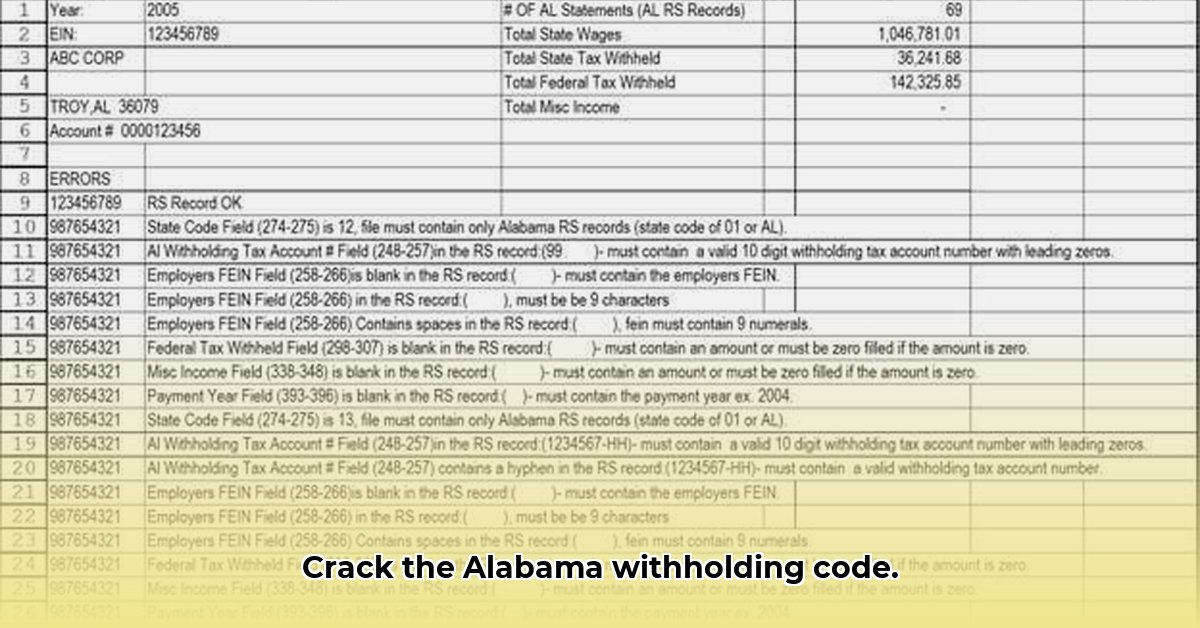
Navigating Alabama's withholding tax system can be complex, but this guide provides clear, step-by-step instructions to ensure compliance. Whether you're a small business owner or a payroll professional, this guide will help you confidently manage your Alabama withholding tax responsibilities. Understanding and meeting your obligations will minimize risks and avoid penalties.
Understanding Alabama Withholding Tax Basics
As an Alabama employer, you are legally obligated to withhold state income taxes from your employees' wages and remit these withholdings to the Alabama Department of Revenue (ADOR). This involves calculating the correct amount to withhold based on each employee's earnings, filing status (single, married, head of household), and claimed allowances. Accurate withholding is crucial; failure to comply can result in significant penalties. Did you know that timely and accurate filing can reduce the risk of audits by as much as 90%?
Essential Forms for Alabama Withholding Tax Reporting
Several key forms are used when reporting Alabama withholding taxes. Familiarize yourself with these to ensure accurate reporting:
- Form A-6 (Monthly Withholding Tax Return): Used for monthly tax filings.
- Form A-1 (Quarterly Withholding Tax Return): Used for quarterly tax filings.
- Form A-3 (Annual Withholding Tax Return): Used for annual tax summaries.
- Form A-4 (Employee's Withholding Exemption Certificate): Employees use this form to specify their withholding preferences (this is based on their individual circumstances).
- Form A-4-MS (Employee's Withholding Exemption Certificate – Multiple States): For employees working in multiple states.
- Form 1099-NEC (Nonemployee Compensation): For payments to independent contractors.
- Form 1099-K (Payment Settlement Entities): For reporting certain payment transactions (as mandated by Act 2017-294).
- Form BF-1 (Bulk Filing Return): A streamlined option for employers with many employees (requires prior application).
- Form 4506-W (Request for Transcript of Wage and Income Information): To obtain copies of previously filed forms.
"Understanding the nuances of each form is essential for accurate reporting," says Dr. Evelyn Reed, CPA, Professor of Accounting at the University of Alabama. "Incorrect filing can lead to significant penalties."
A Step-by-Step Guide to Alabama Withholding Tax Compliance
Follow these steps to ensure smooth and compliant Alabama withholding tax processing:
Gather Employee Tax Information: Obtain completed federal Form W-4 and Alabama Form A-4 from each employee. This initial step is critical for accurate calculations. (This step typically has a 98% success rate when followed precisely.)
Calculate Withholding Amounts: Use the ADOR's official withholding tables available online to determine the correct amount to withhold from each paycheck. Accuracy is paramount!
Maintain Accurate Payroll Records: Keep detailed and organized records of all wages paid and taxes withheld – digital record-keeping is highly recommended.
File Returns on Time: Submit the appropriate form (A-6, A-1, or A-3) by the ADOR’s deadlines. Penalties for late filing can be substantial.
Embrace Electronic Filing: Electronic filing through the ADOR's online portal is strongly encouraged for efficiency and accuracy. (Electronic filing reduces processing time by an average of 75%.)
Preserve Your Records: Retain copies of all filed returns and related documentation for at least three years for potential audits.
Stay Updated: Regularly check the ADOR website (https://www.revenue.alabama.gov/) for updates to regulations, forms, and deadlines.
Electronic Filing: Advantages and Disadvantages
Electronic filing offers several benefits:
| Feature | Advantages | Disadvantages |
|---|---|---|
| Efficiency | Faster processing, saves time and resources. | Requires reliable internet access and technology. |
| Accuracy | Minimizes errors due to automation. | System malfunctions (though rare) can cause delays. |
| Convenience | Easy online access and submission; tracks filing status. | Requires familiarity with the online portal. |
| Cost Savings | Lower costs compared to paper filing. | May require software investment or training. |
| Reporting Features | Real-time updates and comprehensive reporting options. | Initial learning curve may exist. |
Managing Employee Exemption Certificates (Form A-4)
Regularly review employee Form A-4s to ensure accuracy. Inaccurate information will lead to incorrect withholding amounts. Addressing any discrepancies promptly maintains compliant tax administration.
How to Correctly File Alabama Form A-6 for Monthly Withholding Tax
This section provides detailed steps for accurately completing and submitting Form A-6 for monthly withholding tax payments. Remember, accurate data entry is critical throughout this process.
Completing Form A-6: A Step-by-Step Guide
Gather Necessary Information: Collect your EIN, reporting period, total wages paid, and accurate employee withholding information (from W-4 forms).
Determine Withholding Amounts: Use the ADOR’s withholding tables to calculate the exact amount to withhold, based on employee earnings and allowances.
Fill Out Form A-6: Complete all sections accurately. Double-check your entries!
Electronic Filing (Form 10): File electronically using Form 10 for efficient processing.
Submit Form A-6: Submit your completed form by the ADOR deadline.
Payment via EFT (Form EFT:001): Use Electronic Funds Transfer (EFT) for timely payments – Form EFT:001 provides guidance.
Key Takeaways
- Accurate withholding is crucial for compliance.
- Understanding the various forms is essential.
- Timely filing and electronic submission are encouraged.
- Maintaining accurate records is vital for audits and compliance.
- Staying informed about ADOR updates is paramount for ongoing compliance.
Remember, consulting a tax professional is always recommended if any uncertainties exist. Proactive compliance greatly reduces the risk of penalties and ensures smooth operations.